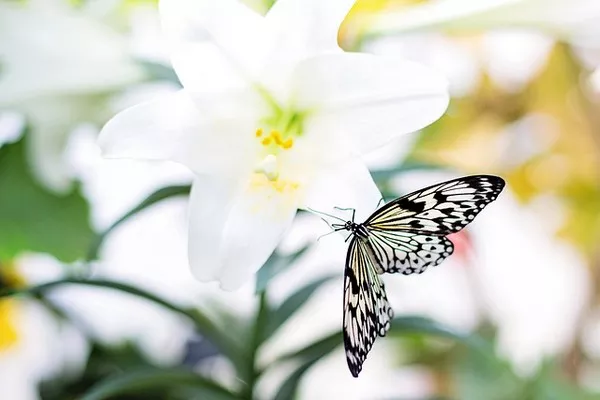A garden teeming with the graceful presence of butterflies is a captivating sight to behold. These delicate creatures are not only mesmerizing but also vital pollinators that contribute to the ecosystem’s health. To create a butterfly haven in your garden, it’s essential to know which flowers hold a special allure for these winged visitors. In this guide, we will explore a selection of enchanting flowers that attract butterflies, transforming your outdoor space into a vibrant and fluttering sanctuary.
Butterfly Bush (Buddleja davidii):
The butterfly bush (Buddleja davidii) is aptly named, as it acts as a magnet for butterflies, drawing them in with its nectar-rich blossoms. This deciduous shrub is native to Asia and comes in a variety of species, each showcasing long panicles of tiny flowers in vibrant colors, such as purple, pink, and white. The sweet fragrance emitted by these blooms acts as an irresistible invitation to butterflies, enticing them from near and far.
What makes the butterfly bush particularly appealing to butterflies is its strategic positioning of flowers in tall spikes, making them easily accessible to these fluttering insects. As butterflies sip nectar from the tubular blooms, they inadvertently pollinate the plant, promoting cross-pollination and genetic diversity. This mutual relationship between the butterfly bush and butterflies enhances both the garden’s beauty and ecological balance.
To maintain the allure of the butterfly bush throughout the growing season, it is crucial to deadhead spent flowers regularly. This encourages continuous blooming, ensuring a steady supply of nectar for visiting butterflies. Furthermore, the butterfly bush is a low-maintenance shrub, making it an ideal addition to butterfly gardens, even for novice gardeners.
Milkweed (Asclepias):
When discussing flowers that attract butterflies, the significance of milkweed (Asclepias) cannot be overstated, particularly for the iconic monarch butterfly. Milkweed serves as the primary host plant for monarch butterflies, as it is the sole source of food for their caterpillars. The plant’s broad leaves provide ample sustenance for the growing caterpillars, allowing them to undergo metamorphosis and emerge as beautiful butterflies.
Milkweed boasts clusters of small, intricate flowers that are a treasure trove of nectar for adult butterflies. These sweet-smelling blooms are a favorite among many butterfly species, including swallowtails, fritillaries, and painted ladies. By planting milkweed, gardeners create a vital habitat that supports the entire life cycle of monarch butterflies, from egg to caterpillar to chrysalis to adult.
As an added bonus, milkweed is also a hardy and resilient plant that adapts well to various climates and soil types. It thrives in both sunny and partially shaded areas, making it a versatile addition to any butterfly garden. To ensure a thriving milkweed population, avoid using harmful pesticides that may inadvertently harm caterpillars and butterflies.
Coneflowers (Echinacea):
Coneflowers (Echinacea) are not only prized for their robust and vibrant blooms but also for their appeal to butterflies and other pollinators. With their striking daisy-like appearance and prominent, cone-shaped centers, coneflowers produce a generous amount of nectar. The bright colors, ranging from pink and purple to white, make them a popular choice in butterfly gardens, attracting an array of winged visitors.
These native North American wildflowers are particularly beloved by native bees and butterflies like painted ladies, swallowtails, and monarchs. As butterflies flit from flower to flower, they facilitate cross-pollination, playing a crucial role in the reproduction of coneflowers and other plants in the garden.
To keep coneflowers blooming throughout the summer, it is essential to deadhead spent flowers regularly. This encourages the plant to produce more blooms and, in turn, provides an abundant supply of nectar for visiting butterflies. Additionally, leaving the seed heads on the plant in the fall provides a source of food for birds and butterflies during the colder months.
Lantana (Lantana camara):
Lantana (Lantana camara) is a true showstopper in any butterfly garden, boasting clusters of small, tubular flowers that change color as they mature. The transition from one hue to another on the same plant is a visual delight, as are the butterflies it attracts. Lantana’s nectar-rich blooms are a favorite among butterflies, hummingbirds, and bees, making it an excellent choice for adding lively colors and buzzing activity to your garden.
Originating from tropical regions of the Americas, lantana thrives in warm climates and full sun, making it ideal for gardens in temperate regions. It comes in various vibrant colors, including shades of yellow, orange, pink, and red, creating a vibrant and eye-catching display. As butterflies flock to the nectar-rich blooms, they help pollinate the plant, contributing to its continued growth and beauty.
Lantana is also known for its ability to attract a diverse array of butterfly species, including monarchs, swallowtails, and painted ladies. Moreover, it is a low-maintenance plant that requires minimal care, making it an excellent addition to butterfly gardens for busy gardeners seeking to support local pollinators.
Zinnias (Zinnia elegans):
Zinnias (Zinnia elegans) are renowned for their vibrant and diverse array of colors, which makes them a popular choice for attracting butterflies. These annual flowers produce a profusion of nectar-rich blossoms that are easy for butterflies to access, making them an irresistible draw for these winged visitors. With their bright and captivating appearance, zinnias not only entice butterflies but also add a cheerful and lively ambiance to your garden.
Native to Mexico and Central America, zinnias have become a staple in butterfly gardens around the world due to their ability to thrive in a variety of conditions and their exceptional bloom production. They come in a wide range of colors, including shades of yellow, orange, pink, red, and purple, giving gardeners ample choices to create vibrant and eye-catching displays.
Butterflies, including monarchs, swallowtails, and painted ladies, flock to zinnias to sip nectar, and in the process, they transfer pollen from one flower to another.


